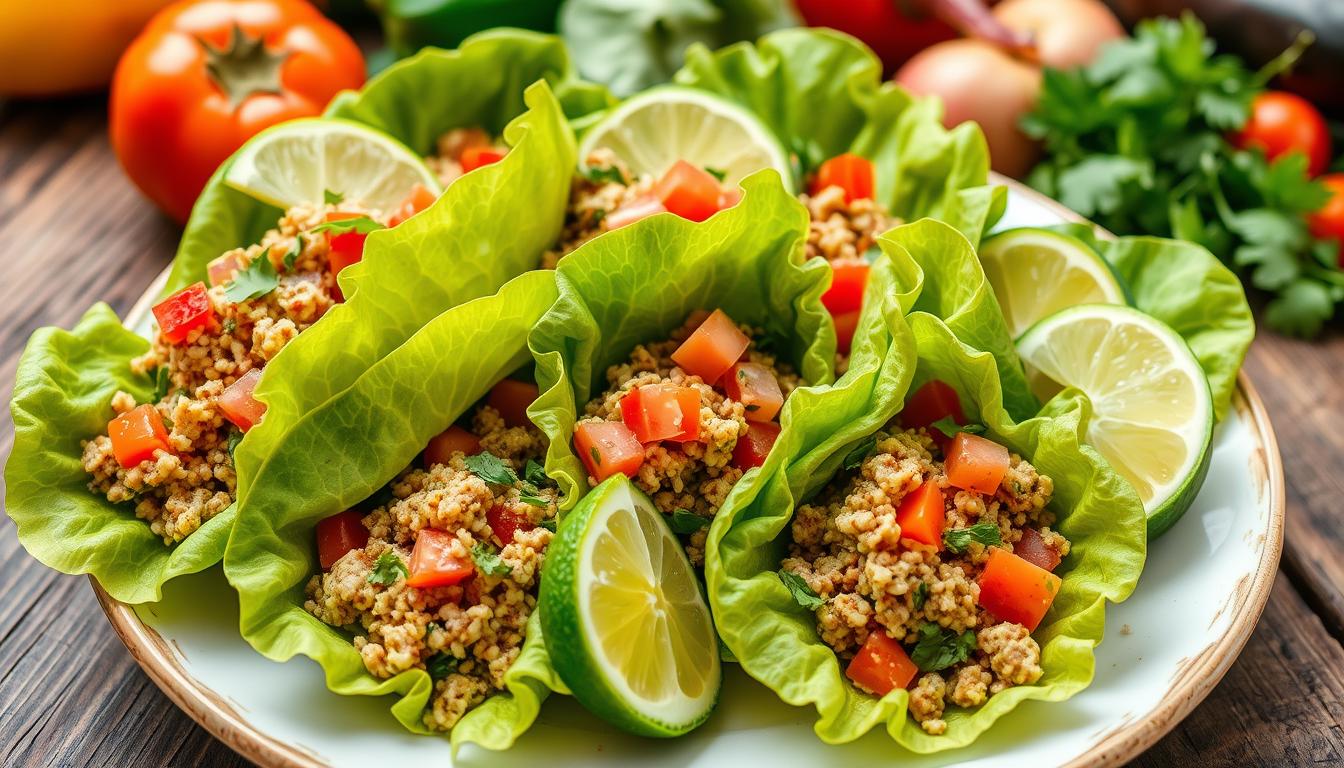Did you know 89% of people with fibromyalgia face fatigue, brain fog, and joint pain? An anti-inflammatory diet can ease these symptoms. This recipe for turkey and quinoa lettuce wraps is a tasty, nutritious meal for those with fibromyalgia.
Fibromyalgia is a chronic condition that affects millions, causing widespread pain, fatigue, and sleep issues. Eating anti-inflammatory foods and balanced meals can help manage symptoms. Enjoy a delicious meal that nourishes your body and boosts your well-being.
Turkey and quinoa lettuce wraps for fibromyalgia
If you have fibromyalgia, finding good meals can be hard. But, with the right ingredients, you can make tasty dishes that help your body. One great option is turkey and quinoa lettuce wraps.
Turkey is lean and keeps your energy up. Quinoa is gluten-free and full of fiber. Wrapping them in lettuce makes a meal that’s light but filling. You can also change it up to suit your taste.
To make these fibromyalgia-friendly meals, add anti-inflammatory herbs like turmeric, ginger, or garlic. Turkey and quinoa together make a great lunch idea for managing symptoms.
Try different toppings and condiments to find what you like. Add avocado, tomatoes, fresh herbs, and olive oil for endless flavors. With a bit of creativity, you can make a meal that’s both delicious and anti-inflammatory.
What is an anti-inflammatory diet?
An anti-inflammatory diet is all about eating foods that fight inflammation. Chronic inflammation can cause many health problems, like weight gain and heart disease. By choosing the right foods, you can help your body stay healthy.
Inflammation and Its Effects on the Body
Inflammation is how our body reacts to injury or infection. But, when it lasts too long, it can cause serious health issues. These include heart disease, diabetes, cancer, and Alzheimer’s disease. Eating the right foods can help control this inflammation.
Foods that Reduce Inflammation
The heart of an anti-inflammatory diet is eating whole, nutrient-rich foods. These foods are full of antioxidants and compounds that fight inflammation. Some top choices are:
- Fatty fish like salmon, mackerel, and sardines, which are high in omega-3 fatty acids
- Leafy greens, berries, and other colorful fruits and vegetables, which are packed with antioxidants
- Whole grains, nuts, and seeds, which provide fiber and healthy fats
- Herbs and spices like turmeric, ginger, and garlic, which have potent anti-inflammatory properties
Eating these foods and avoiding processed, high-sugar, and high-fat foods can help reduce inflammation. This supports your overall health.
Benefits of a fibromyalgia-friendly diet
Following an anti-inflammatory diet can greatly benefit those with fibromyalgia. It helps reduce inflammation, which can ease chronic pain and boost energy. Eating nutrient-rich foods ensures your body gets the vitamins and minerals it needs.
Some key advantages of a fibromyalgia-friendly diet include:
- Less inflammation means less pain and stiffness
- More energy and less fatigue
- Better sleep, which is key for managing symptoms
- Improved mood and less anxiety or depression
- A stronger immune system to fight off the condition
- A healthier gut microbiome for better overall health
By choosing foods that reduce inflammation, like fruits, veggies, whole grains, and lean proteins, you’re taking a big step. This can help manage your fibromyalgia and improve your life quality.
Keep in mind, a fibromyalgia-friendly diet is tailored to each person. It’s vital to work with your healthcare team to find the best diet for you. With the right nutrition, you can alleviate chronic pain and support your health.
Lean protein sources for fibromyalgia
Eating enough lean protein is key for those with fibromyalgia. It helps muscles work better and recover faster. Turkey is a great choice because it’s low in fat and packed with amino acids. Adding turkey to meals, like lettuce wraps, can be a good way to get enough protein.
Turkey as a Lean Protein Option
Turkey is a flexible and lean protein source for a high-protein meal plan. It’s low in fat and full of amino acids, which are good for muscles. Choosing turkey for dishes like turkey and quinoa lettuce wraps can make meals more nutritious and satisfying. This might help ease some fibromyalgia symptoms.
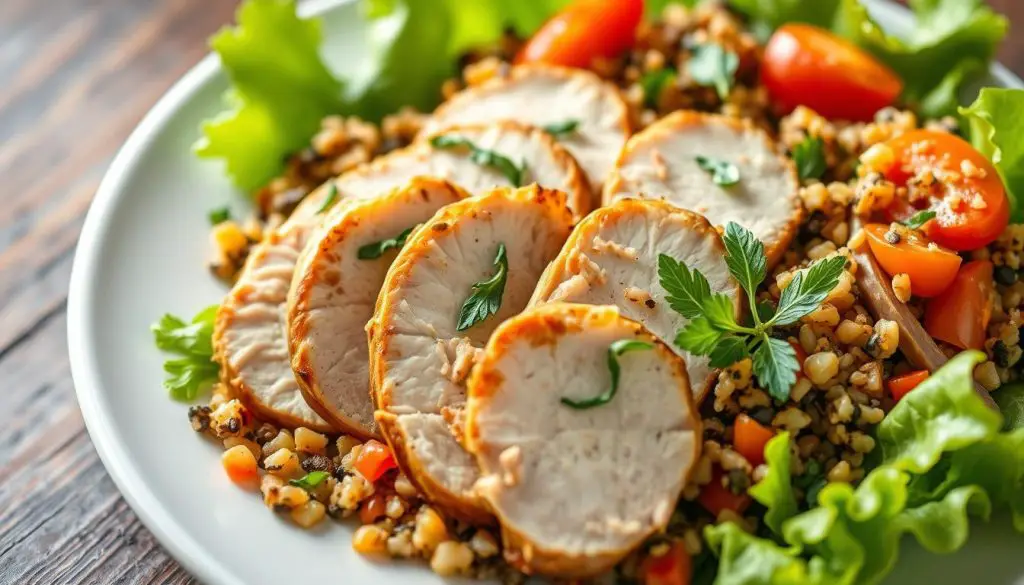
- Chicken breast
- Lean beef
- Salmon
- Eggs
- Legumes (e.g., lentils, chickpeas)
- Greek yogurt
Mixing different lean protein sources into your diet is important. It helps meet your daily protein needs. This is vital for managing fibromyalgia symptoms and keeping your body healthy.
Quinoa: A nutritious gluten-free grain
Quinoa is a nutrient-rich, gluten-free grain that’s great for fibromyalgia sufferers. It’s packed with fiber, protein, and vitamins and minerals. This makes it a top choice for a fibromyalgia-friendly diet.
Quinoa has anti-inflammatory properties. It’s full of antioxidants and polyphenols that fight inflammation. It also has omega-3 fatty acids that help with joint pain and improve health.
Being gluten-free, quinoa is safe for those who can’t eat gluten. Studies show a gluten-free diet can greatly help those with celiac disease. It improves their life quality by a lot.
Pairing quinoa with lean turkey in lettuce wraps makes a balanced meal. This meal gives you energy and helps your body heal. Adding quinoa to your diet can boost your health and well-being.
Preparing turkey and quinoa lettuce wraps
Making turkey and quinoa lettuce wraps is simple. They’re great for those with fibromyalgia looking for easy, fibromyalgia-friendly meals. This recipe mixes lean turkey, quinoa, and veggies with anti-inflammatory herbs and spices. It’s a healthy lunch idea that’s easy to make and very tasty.
Ingredients
- 1 lb ground turkey
- 1 cup cooked quinoa
- 1 cup diced bell peppers
- 1/2 cup grated carrots
- 1/4 cup chopped fresh cilantro
- 2 tablespoons Dijon mustard
- 1 teaspoon ground cumin
- 1/2 teaspoon garlic powder
- Salt and pepper to taste
- 12-15 large lettuce leaves (such as romaine or butter lettuce)
Cooking Instructions
- Cook the ground turkey in a large skillet over medium heat until it’s browned and cooked through, 5-7 minutes. Drain any extra fat.
- Add the cooked quinoa, diced bell peppers, grated carrots, chopped cilantro, Dijon mustard, cumin, and garlic powder to the skillet. Stir well.
- Season the turkey and quinoa mix with salt and pepper to taste.
- Put the filling into the lettuce leaves to make individual wraps.
- Serve the turkey and quinoa lettuce wraps right away and enjoy!
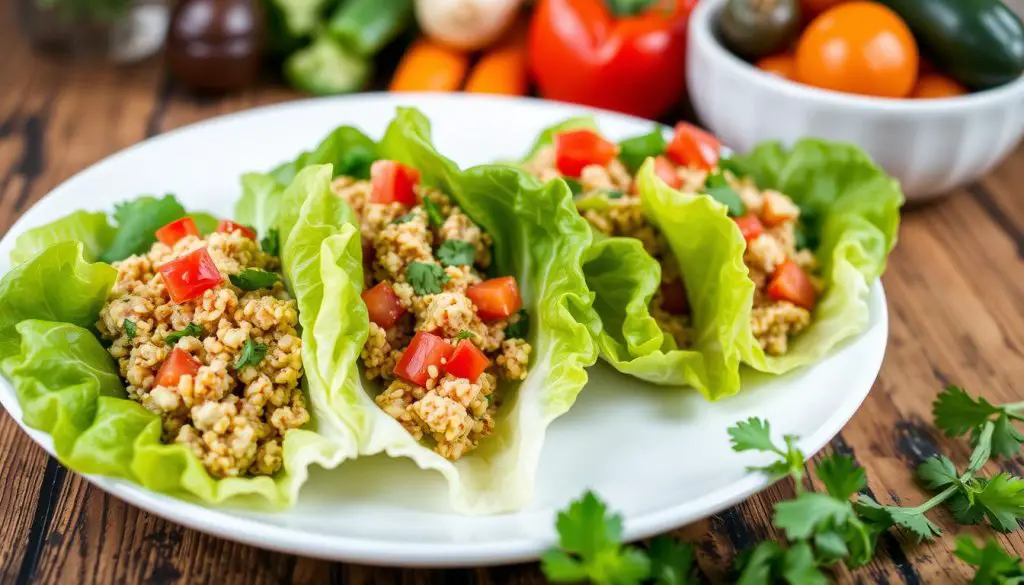
These turkey and quinoa lettuce wraps are not just easy fibromyalgia-friendly meals. They’re also a healthy lunch idea full of flavor and nutrients. They include lean protein, complex carbs, and fresh veggies. This supports the anti-inflammatory diet needed for fibromyalgia.
Incorporating anti-inflammatory herbs and spices
Adding anti-inflammatory herbs and spices to your turkey and quinoa lettuce wraps can boost their benefits. Seasonings like turmeric, ginger, and garlic have strong anti-inflammatory effects. These can help lessen pain and swelling linked to fibromyalgia.
Turmeric has curcumin, a compound with strong anti-inflammatory properties. Ginger is good for fibromyalgia as it eases muscle and joint pain. Garlic adds flavor and has allicin, which is anti-inflammatory.
Using these anti-inflammatory herbs and spices in your turkey and quinoa wraps makes them fibromyalgia-friendly. They offer natural pain relief and make your meal taste better and be more nutritious.
Enhancing Flavor and Nutrition
To get the most from these anti-inflammatory herbs and spices, try these ideas:
- Add a sprinkle of turmeric to the quinoa as it cooks for a bright color and earthy taste.
- Grate fresh ginger into the turkey or use it for a quick dressing for the wraps.
- Mince garlic and sauté it with the turkey before making the wraps.
By adding these fibromyalgia-friendly seasonings thoughtfully, you make a meal that’s tasty and good for you. It helps with natural pain relief and supports your health.
Healthy lettuce wrap alternatives
While turkey and quinoa lettuce wraps are tasty and good for fibromyalgia, there are other healthy choices. Collard greens, cabbage leaves, or gluten-free options can be great bases. They let you pick the right wrap for your diet, whether you want low-carb, grain-free, or different textures.
For gluten-free options, try large leaves of romaine lettuce or butter. These leaves are crisp and refreshing, perfect for holding the turkey and quinoa mix. You can also use thinly sliced zucchini or eggplant as wraps.
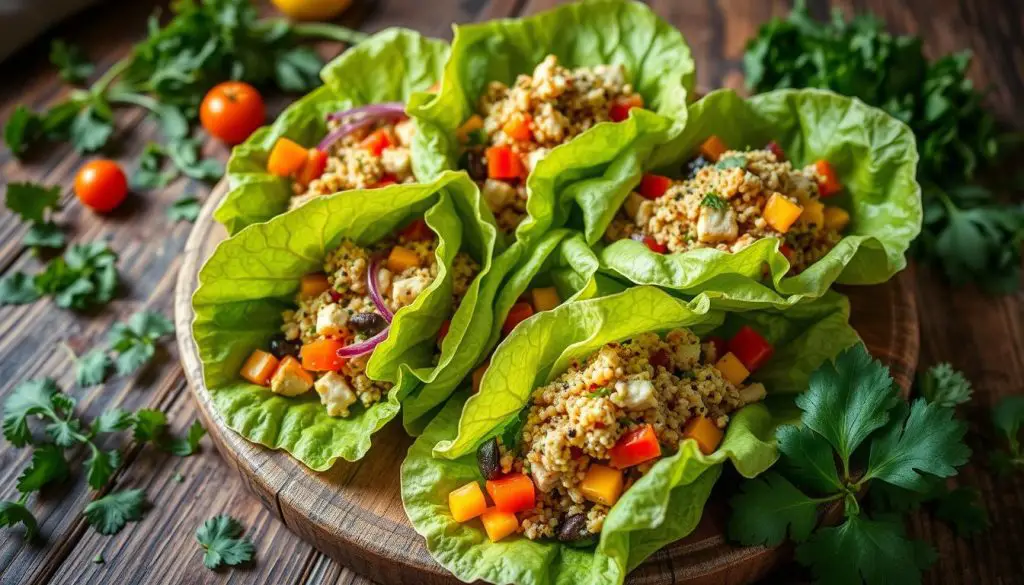
Choosing the right wrap is about finding balance in nutrition, texture, and taste. Try different greens, veggies, and gluten-free options. This way, you’ll find the best wrap for your tasty turkey and quinoa filling.
Meal prepping for fibromyalgia management
Preparing meals ahead of time is a smart move for those with fibromyalgia. Meal prepping ensures you have healthy, anti-inflammatory meals ready when you need them. The turkey and quinoa lettuce wraps are great for making in bulk and keeping on hand all week.
Tips for Batch Cooking
- Set aside a few hours on the weekend to prepare multiple servings of the turkey and quinoa lettuce wraps.
- Cook the quinoa and turkey in large batches, then assemble the lettuce wraps and store them in airtight containers in the refrigerator.
- Chop the vegetables and prepare the lettuce leaves in advance for easy assembly later.
- Utilize time-saving meal prepping techniques, such as cooking extra servings of the quinoa and turkey to use in other dishes throughout the week.
- Experiment with different combination of fillings and toppings to keep your meals interesting and varied.
By batch cooking these turkey and quinoa lettuce wraps, you can have quick, healthy meals ready when needed. This time-saving meal idea helps manage fibromyalgia symptoms and keeps your diet balanced.
Balancing nutrition for chronic pain relief
For those with fibromyalgia, a balanced diet is key. It helps the body manage chronic pain and other symptoms. The turkey and quinoa lettuce wraps offer a mix of lean protein, complex carbs, and anti-inflammatory ingredients. This combination meets the complex needs of fibromyalgia patients.
Proper nutrition is vital for reducing inflammation, a major cause of chronic pain. A diet rich in balanced nutrition for fibromyalgia helps the body handle chronic pain management better. The anti-inflammatory diet focuses on whole, unprocessed foods. These foods can lower inflammation and ease symptoms.
- Chewing food thoroughly (about 25 times) aids in nutrient absorption.
- Recommended water intake is ½ your body weight in ounces daily.
- Ideal bedtime for improved digestion and adrenal recovery is by 10 p.m.
- Eating every 2-3 hours is suggested, with 3 small meals and 2-3 snacks daily.
Adding nutrients like B vitamins, magnesium, and potassium can also help. They support stress management and overall well-being. By focusing on a balanced nutrition for fibromyalgia, you can manage your chronic pain and enhance your life quality.
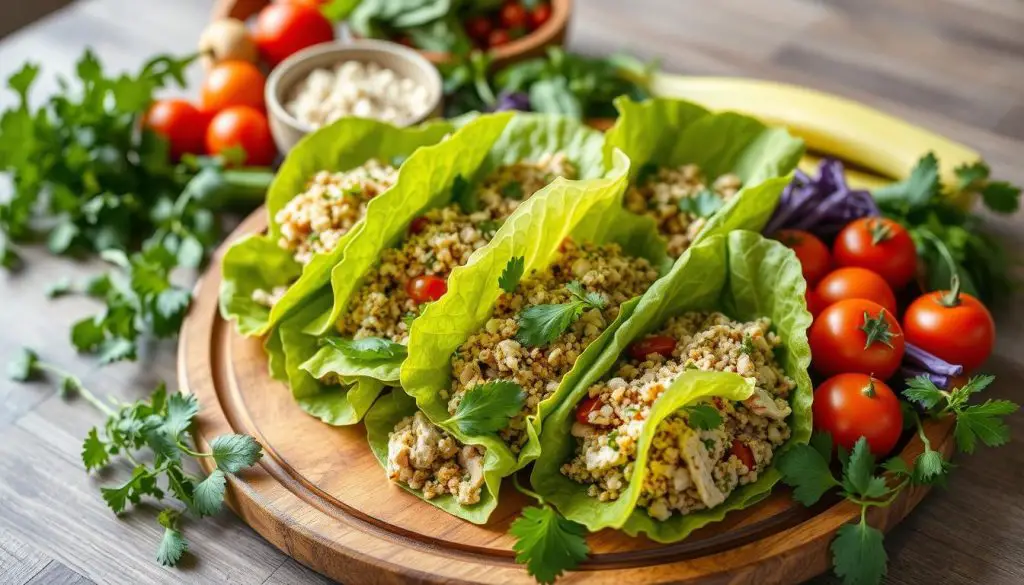
Customizing the recipe for personal preferences
The turkey and quinoa lettuce wraps are great for those with fibromyalgia. You can change the recipe to fit your taste and dietary needs. You can swap the protein, lettuce type, or add toppings to make it your own.
Want to try something different? Use grilled chicken or baked salmon instead of turkey. Choose a lean protein that’s easy to digest. You can also pick from different lettuces like romaine or kale to match your taste.
Adding your favorite herbs and spices can make the dish even better. Turmeric, ginger, and garlic are great for fighting inflammation. They can also make the meal more flavorful.
Being able to adjust your meals is key for fibromyalgia sufferers. By customizing fibromyalgia-friendly recipes and making personal diet modifications, you can enjoy a meal that’s both healthy and delicious.
| Ingredient | Quantity |
|---|---|
| Turkey | 1 lb (454g) |
| Quinoa | 1 cup (185g) |
| Romaine lettuce leaves | 12 leaves |
| Avocado | 1 medium (200g) |
| Tomatoes | 2 medium (264g) |
| Onion | 1 small (100g) |
| Garlic | 2 cloves (6g) |
| Olive oil | 2 tbsp (28ml) |
| Salt and pepper | To taste |
Fibromyalgia-friendly snack ideas
Nutrition is key in managing fibromyalgia. It helps control symptoms and boosts well-being. There are many fibromyalgia-friendly snack options that are both tasty and nutritious.
Choosing foods like fresh fruits, vegetables, nuts, and seeds is smart. These anti-inflammatory snack options keep your energy up and fight inflammation. This is important for managing fibromyalgia.
For a good healthy snacking experience for chronic pain, try these ideas:
- Sliced cucumber with hummus or guacamole
- Apple slices with almond butter
- Carrots and celery sticks with creamy avocado dip
- Roasted chickpeas seasoned with turmeric and paprika
- Mixed berries with a sprinkle of unsweetened coconut flakes
- Kale chips made with olive oil and sea salt
- Hard-boiled eggs with a pinch of black pepper
Adding these fibromyalgia-friendly snacks to your diet helps your body get the nutrients it needs. This way, you can manage your condition better and eat a balanced diet.
Choosing whole, unprocessed foods is the best strategy for snacking with fibromyalgia. By making smart choices and planning, you can help your body thrive, even with chronic pain.
Staying hydrated with fibromyalgia
Proper hydration is key for those with fibromyalgia. Dehydration can make symptoms like fatigue and muscle pain worse. Drinking enough water and eating foods high in water, like fruits and veggies, helps your body heal and feel better.
Here are some tips to stay hydrated with fibromyalgia:
- Drink at least eight 8-ounce glasses of water a day. More if you’re active or live in a hot place.
- Carry a refillable water bottle. Drink from it all day to stay hydrated by habit.
- Eat hydrating foods like watermelon, cucumber, oranges, and leafy greens.
- Stay away from caffeinated drinks like coffee and soda. They can make you dehydrated.
- Pay attention to signs like dry mouth, headaches, or feeling tired. These might mean you need more water.
By focusing on hydration, you can better manage fatigue and pain from fibromyalgia. It also supports your overall health.
Combining diet and exercise for fibromyalgia
Managing fibromyalgia needs a whole-body approach. Eating right and staying active can make a big difference. A diet like the turkey and quinoa lettuce wraps can help with pain and symptoms. Adding gentle exercises to your routine can also boost your health.
Try low-impact activities like yoga, Tai Chi, or light cardio. These can strengthen muscles, improve flexibility, and boost endurance. They’re great for fibromyalgia because they ease stiffness, reduce tiredness, and lift your mood.
When you start exercising, begin slowly and listen to your body. Too much can make symptoms worse. Aim for a mix of diet changes and exercises that fit your needs and abilities.
By eating anti-inflammatory foods and doing gentle exercises, you can manage fibromyalgia better. This holistic approach can improve your health and well-being.
Tips for Combining Diet and Exercise
- Start with low-impact activities like yoga, Tai Chi, or light walking to build strength and flexibility.
- Gradually increase the duration and intensity of your physical activity as your body adapts.
- Ensure you are adequately hydrated and fueled with nutrient-dense, anti-inflammatory foods.
- Rest and recover between exercise sessions, allowing your body to recuperate.
- Consult with a healthcare professional to develop a personalized plan that addresses your specific needs and limitations.
By combining a fibromyalgia-friendly diet with gentle exercises, you can manage chronic pain better. This holistic approach can greatly improve your quality of life.
Seeking professional guidance for fibromyalgia
Fibromyalgia can be tough to handle on your own. Getting help from doctors and other health experts is key. They can help you make a plan that fits your needs, like changing your diet and finding ways to ease symptoms.
Having a team of healthcare professionals by your side is very helpful. They can teach you how food affects your symptoms and suggest good eating habits. They also keep an eye on how well your plan is working and make changes as needed.
Seeing a doctor who knows a lot about fibromyalgia can be a big help. They can guide you on dietary changes and help with other health issues. This way, you get a plan that works for you, including food changes and other treatments.
Source Links
- https://www.amysthilaire.com/blog/2019/5/7/kill-your-chronic-pain-eliminate-the-bad-foods-focus-on-the-good
- https://nourishingmeals.com/diet/basic-elimination-diet
- https://www.naturopathtoronto.ca/10-delicious-low-carb-dinner-recipes-for-weight-loss/
- https://www.confrontingchronicpain.com/your-nutrition-plan-for-chronic-pain/
- https://www.fischerfamilychiro.com/healthy-recipes.html
- https://healthandnutrition.ie/category/food-intolerance/page/2/
- https://www.healthline.com/health/rheumatoid-arthritis/seven-day-meal-plan
- https://www.arthritisfoundationasia.com/anti-inflammatory-diet-arthritis.html
- https://extension.usu.edu/nutrition/research/chronic-pain
- http://www.veganforum.com/forums/archive/index.php/t-6536.html
- https://www.ncbi.nlm.nih.gov/pmc/articles/PMC8078476/
- https://www.healthline.com/nutrition/easy-healthy-meals
- https://thatshealth.com/2018/11/06/dietary-guidelines-for-repairing-health/
- https://www.ncbi.nlm.nih.gov/pmc/articles/PMC10459186/
- https://www.mindfulnessinfaithandfood.com/dietitian-approved-healthy-gluten-free-snacks/
- https://www.healthline.com/nutrition/celiac-disease-diet
- https://sevenlayercharlotte.com/2018/06/10/gluten-free-q/
- https://clemandthyme.com/2018/03/23/katies-leap-journey-phase-1/
- http://caseythecollegeceliac.blogspot.com/2019/08/47-gluten-free-sandwich-salad-recipes-back-to-school.html
- https://www.julienutrition.com/introduce-vegetables-diet/
- https://www.functionaldiagnostichealing.com/blog
- https://www.aol.com/65-best-healthy-recipes-weight-133027848.html
- https://locations.seniorshelpingseniors.com/nc/wakeforest/blog-109.html
- https://www.healthline.com/nutrition/3000-calorie-meal-plan
- https://www.mobeforlife.com/resources
- http://www.chewfo.com/diets/clean-by-alejandro-junger-m-d-2012-what-to-eat-and-foods-to-avoid-food-list/
- https://awellness.com/index.php/healthy-food-choices/
- https://drmindypelz.com/wp-content/uploads/2020/01/reset-factor-book.pdf
- https://www.healthline.com/nutrition/no-carb-diet
- https://www.wellplated.com/detox-salad/
- https://www.healthline.com/nutrition/weight-loss-meal-plan
- https://www.living-smarter-with-fibromyalgia.com/gluten-free.html
- https://www.eatingwell.com/30-minute-anti-inflammatory-chicken-dinner-recipes-8606692
- https://blog.katescarlata.com/fodmaps-basics/fodmaps-menu-and-snacks/
- https://www.ncbi.nlm.nih.gov/pmc/articles/PMC4488002/
- https://www.fibrofix.com/pages/21-day-detox
- https://www.healthline.com/nutrition/1500-calorie-diet
- https://www.recoveryguru.com.au/blog/7-best-healthy-power-meals-to-keep-you-charged-all-day/
- https://www.in.gov/health/files/2_TAB_1.pdf
- https://www.healthline.com/nutrition/healthy-lunch-ideas-for-weight-loss
